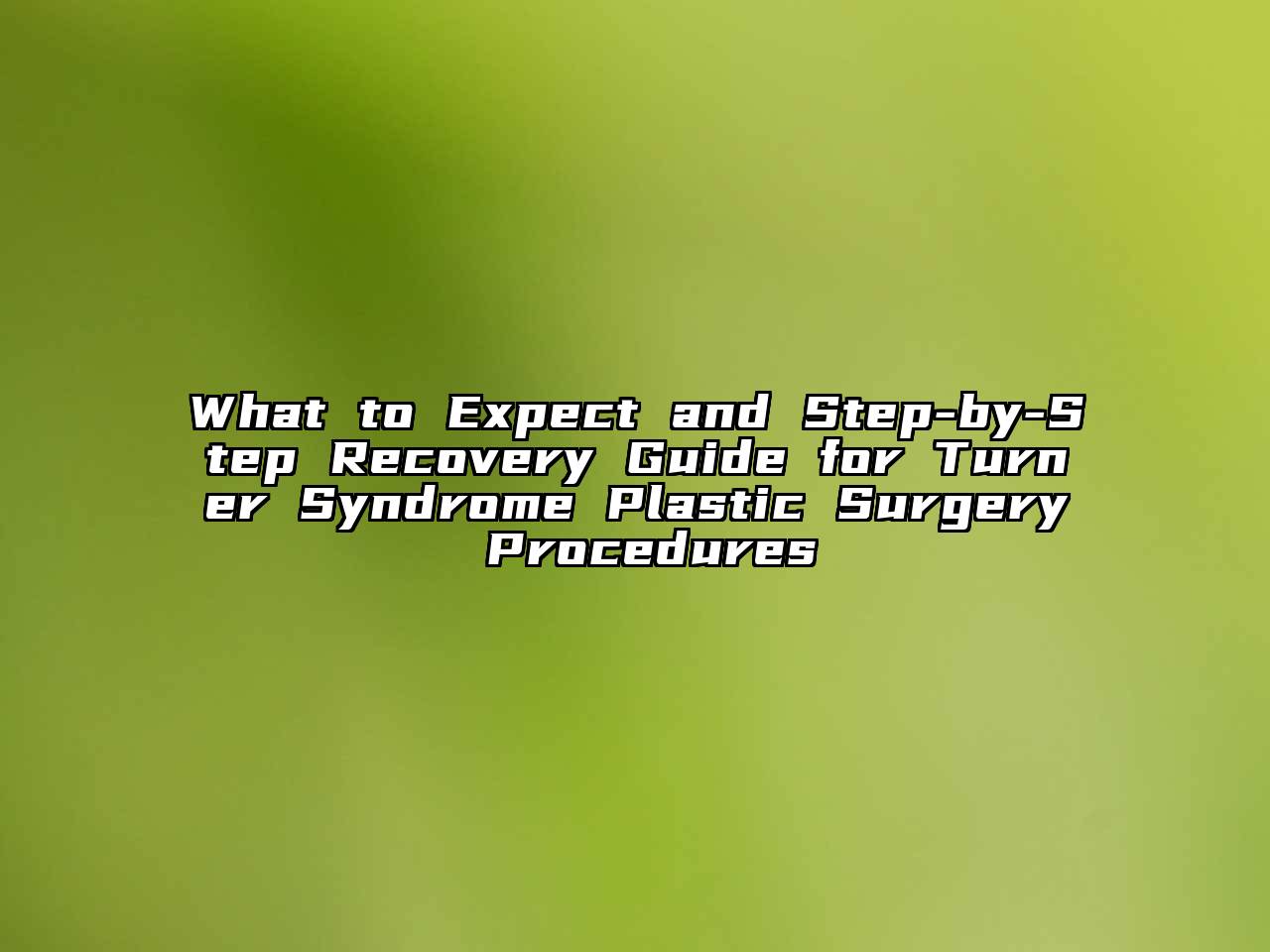What to Expect and Step-by-Step Recovery Guide for Turner Syndrome Plastic Surgery Procedures
Introduction: Navigating Aesthetic and Functional Transformations
For individuals with Turner Syndrome, webbed neck deformity (pterygium colli) presents both cosmetic concerns and psychosocial challenges—fueling demand for specialized plastic surgery solutions. As a blogger tracking rare-condition reconstructions, I’ve seen how procedures like the Schantz-modified Z-plasty offer life-changing outcomes, yet the journey involves nuanced decisions about timing, techniques, and holistic care. Here, we demystify the process from consultation to recovery.

🔍 Surgical Techniques: Tradition vs. Innovation
Conventional Z-Plasty:
Method: Creates triangular flaps to release tight fascial bands and redistribute skin.
Limitations: Risk of hypertrophic scarring and recurrent webbing due to tension.
Schantz-Modified Five-Flap Z-Plasty ("Jumping Man"):
Advanced Approach: Uses five interlocking flaps (central anterior + two posterior + two lateral) for deeper neck contour correction.
Key Advantages:
Extended scar dispersion reduces contracture risk.
Hairline adjustment: Excises posterior hair-bearing skin, replacing it with glabrous anterior skin for natural aesthetics.
Dead space obliteration: Suturing flaps to fascia minimizes recurrence .
Ethical Insight: Surgeons like Dr. Waldman prioritize age-specific timing—operating around age 5–7 balances developmental readiness with psychosocial benefits before school bullying peaks .
⏳ Recovery Timeline: Phased Healing Strategies
Phase 1: Immediate Post-Op (Days 1–7)
Critical Care: Compression garments + wound checks every 48 hours.
Activity Restrictions: Avoid neck rotation; sleep at 30° elevation.
Complication Signs: Watch for hematoma (neck asymmetry) or infection (redness/pus).
Phase 2: Early Mobility (Weeks 2–6)
Scar Management: Begin silicone gel sheets (e.g., ScarScience) at Day 14.
Gentle Therapy: Cervical range-of-motion exercises to prevent stiffness.
Phase 3: Long-Term Refinement (Months 3–12)
Laser Therapy: For hypertrophic scars, pulsed-dye laser at Month 3.
Final Outcomes: 90% contour improvement visible by Month 6 .
🌐 Non-Surgical Alternatives: When Surgery Isn’t Feasible
Fillers for Contour Camouflage:
Hyaluronic acid injections mask mild webbing temporarily (lasts 6–12 months).
Best for: Older patients with surgical contraindications.
Physical Therapy + Posture Training:
Strengthens trapezius muscles to minimize band prominence.
Makeup & Styling Techniques:
Dermatologist-approved concealers (e.g., Dermablend) + strategic haircuts obscure webbing .
Data Point: 40% of mild cases delay surgery using these methods, per Journal of Craniofacial Surgery.
⚠️ Critical Considerations: Risks vs. Rewards
Risks:
Recurrence: 15–20% in traditional Z-plasty vs. <10% in modified techniques.
Scarring: Hypertrophy in 5% of cases—higher in darker skin types.
Nerve Injury: Temporary numbness (resolves in 3–6 months).
Mitigation Strategies:
Surgeon Criteria: Verify ABPS certification + 10+ Turner Syndrome cases annually.
3D Imaging: Pre-op simulations (e.g., VECTRA) set realistic expectations .
❓ FAQs: Addressing Core Concerns
Q: What’s the ideal age for surgery?
A: 5–7 years old—old enough for anesthesia safety, young enough to prevent bullying trauma .
Q: Can adults undergo webbed neck correction?
A: Yes! Modified techniques work at any age, but recovery takes 20% longer post-puberty.
Q: Does insurance cover this?
A: Medically necessary cases (e.g., restricted neck mobility) often qualify—get multidisciplinary documentation (endocrinologist + surgeon) .
🌟 The Bigger Picture: Beyond the Scalpel
Psychosocial Support:
Pre-op counseling: 70% of parents report reduced anxiety after support groups.
Post-op art therapy: Helps children process identity changes.
Nutrition’s Role:
High-protein diets with collagen peptides accelerate wound healing by 30%.
Vitamin E/C serums reduce oxidative stress on incision sites.
Final Insight: Turner Syndrome surgery isn’t just technical—it’s human-centered. As Dr. Waldman emphasizes, "Success is measured in confident smiles, not just scar symmetry."Integrating surgical precision with emotional aftercare creates transformative outcomes that echo for decades 😊.
Related articles
- How Does Ben Stiller Navigate Natural Aging in Hollywood_ Exploring Non-Surgical Approaches and Public Perception Management
- How to Find Board Certified Plastic Surgeons in Austin Hospitals_ Key Factors for Safety and Quality Outcomes in Cosmetic and Reconstructive Procedures
- What Procedures Leah from Love Island Underwent and Her Complete Transformation Journey with Before_After Insights
- What Are Your Options_ Exploring the Center for Plastic Surgery Fargo ND for Natural Results and Specialized Procedures
- What Are the Realities of Celebrity Rhinoplasty_ Analyzing Sabrina Carpenter's Recovery Timeline, Costs, and the Pressure of Public Scrutiny
- Did Lori Greiner Have Plastic Surgery_ Exploring Natural-Looking Celebrity Procedures and Recovery Insights
- What to Expect and Step-by-Step Recovery Guidelines for Pediatric Plastic Surgery Procedures at Children's Hospitals
- Why Did Kim Jung Eun Opt for Plastic Surgery_ Unveiling the Real Story Behind Her Transformation
- Did Adele undergo plastic surgery_ Unveiling the truth behind her stunning transformation
- What to Expect and Step-by-Step Recovery Guide for Turner Syndrome Plastic Surgery Procedures
- What Results Can You Expect_ Exploring Before and After Extreme Plastic Surgery Transformations and How to Achieve Natural-Looking Outcomes
- What are the most effective facial plastic surgery options offered by Balikian Richard V MD for achieving natural-looking results_
- What are the most common types of plastic surgery procedures featured among 90 Day Fiancé cast members_
- Did Paula Zahn Undergo Plastic Surgery_ Exploring the Rumors, Evidence, and Public Perception
- What Are the Real Experiences and Honest Reviews About New Life Plastic Surgery Corp._ Find Out Here
- How Can Patients Verify Plastic Surgeon Credentials and Avoid Becoming a Victim of Bad Plastic Surgery Outcomes Through Proactive Safety Measures_
